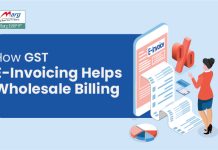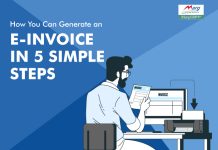Recent Updates on e-Invoicing:
10th May 2023
To support the government’s objective of transitioning to a digital economy, the CBIC has unveiled the commencement of the 6th phase of e-invoicing. Starting from August 1st, 2023, companies with an annual turnover of ?5 crore or above from the fiscal year 2017-18 onwards will be obligated to generate electronic invoices.
Introduction
In today’s fast-paced digital era, businesses are constantly seeking innovative solutions to streamline their operations and enhance efficiency. One area that has witnessed significant transformation is invoicing. Gone are the days of paper-based invoices that often resulted in time-consuming manual processes, errors, and delays. The advent of technology has given rise to electronic invoicing systems, or e-invoicing, revolutionizing the way businesses manage their financial transactions. In this blog, we will explore the benefits and functionalities of e-invoice systems, highlighting how they have transformed the invoicing landscape.
The Concept of E-Invoice Systems:
E-invoicing is a digital alternative to traditional paper-based invoicing processes. It involves the creation, transmission, and receipt of invoices electronically in a standardized format. Instead of printing and sending physical documents, e-invoicing enables businesses to generate, deliver, and process invoices electronically, resulting in a more streamlined and efficient workflow.
Benefits of E-Invoice Systems:
2.1 Enhanced Efficiency: E-invoice systems significantly improve the speed and accuracy of invoicing processes. Automation reduces manual errors and eliminates the need for repetitive data entry, saving valuable time and resources.
2.2 Cost Reduction: Adopting e-invoicing eliminates the costs associated with paper, printing, postage, and manual processing. Furthermore, it reduces the likelihood of errors and disputes, reducing administrative costs and improving overall financial efficiency.
2.3 Faster Payments: E-invoicing expedites payment cycles by minimizing delays caused by postal delivery or manual handling. Real-time delivery and digital payment integration enable faster invoice approval and prompt payment, improving cash flow for businesses.
2.4 Environmental Sustainability: E-invoice systems contribute to eco-friendly practices by reducing paper consumption and waste generation. By embracing digital invoicing, businesses can demonstrate their commitment to sustainability while reducing their carbon footprint.
Key Features of E-Invoice Systems:
3.1 Standardized Formats: E-invoice systems utilize standardized formats such as XML or EDI, ensuring compatibility and seamless integration with various accounting and enterprise resource planning (ERP) systems.
3.2 Automated Workflows: These systems automate invoice creation, approval, and delivery processes, eliminating manual intervention and reducing the risk of errors. Workflow automation enhances productivity and allows for better resource allocation.
3.3 Data Accuracy and Security: E-invoice systems ensure the accuracy and integrity of data by validating information in real-time, minimizing the possibility of errors. Secure transmission protocols and encryption techniques protect sensitive financial data, maintaining confidentiality and compliance with data protection regulations.
3.4 Integration Capabilities: E-invoice systems seamlessly integrate with other business systems, such as ERP, accounting software, and payment gateways, providing a comprehensive and connected ecosystem for managing financial transactions.
Global Adoption and Regulatory Frameworks:
E-invoicing has gained significant traction globally, with many countries adopting e-invoice frameworks and mandates. Governments recognize the potential benefits of e-invoicing in combating tax evasion, increasing transparency, and reducing administrative burdens. Therefore, businesses need to stay updated with country-specific regulations to ensure compliance while leveraging the advantages of e-invoice systems.
The Future of E-Invoice Systems:
As technology continues to advance, e-invoice systems are expected to evolve further. Integration with emerging technologies like artificial intelligence (AI) and machine learning (ML) can enhance automation, data analysis, and predictive capabilities, providing deeper insights into financial processes. Furthermore, blockchain technology may play a crucial role in ensuring the authenticity, traceability, and immutability of invoices, enhancing trust and security.
Conclusion
E-invoice systems have revolutionized the invoicing landscape by offering businesses a more efficient, cost-effective, and sustainable way to manage financial transactions.
Read more useful content:
Frequently Asked Questions (FAQs)
Q. What is an e-invoice system?
An e-invoice system is a digital solution that enables businesses to create, transmit, and receive invoices electronically. It replaces the traditional paper-based invoicing process with a streamlined, automated workflow.
Q. How does an e-invoice system work?
E-invoice systems typically involve the creation of invoices in a standardized electronic format, such as XML or EDI. These invoices are then transmitted electronically to the recipient, either through email, a dedicated portal, or integrated directly into their accounting or ERP system. The recipient can review, approve, and process the invoice digitally, improving efficiency and reducing manual errors.
Q. What are the benefits of using an e-invoice system?
Some key benefits of using an e-invoice system include:
Increased efficiency and productivity through automation
Cost savings from reduced paper usage, printing, and postage
Faster payment cycles and improved cash flow
Enhanced accuracy and reduced errors
Environmental sustainability by reducing paper waste
Seamless integration with accounting and ERP systems
Q. Is e-invoicing legally recognized?
Yes, e-invoicing is legally recognized in many countries. Governments have introduced regulatory frameworks and standards to facilitate the adoption of e-invoicing, ensuring its compliance with tax regulations and legal requirements. It is essential to stay updated on the specific regulations of the country in which you operate.
Q. Are e-invoice systems secure?
E-invoice systems employ various security measures to ensure the confidentiality, integrity, and authenticity of invoices and financial data. These include secure transmission protocols, encryption techniques, digital signatures, and access controls. It is crucial to choose a reputable e-invoice system provider that prioritizes data security.
Q. Can e-invoice systems integrate with existing accounting or ERP software?
Yes, most e-invoice systems are designed to integrate seamlessly with existing accounting or ERP software. Integration enables a smooth exchange of data between systems, reducing manual data entry and improving accuracy. It is advisable to choose an e-invoice system that offers compatibility with your preferred software solutions.
Q. Are e-invoice systems suitable for small businesses?
E-invoice systems are beneficial for businesses of all sizes, including small businesses. They offer cost savings, efficiency gains, and improved cash flow, which are particularly advantageous for small businesses with limited resources. Additionally, e-invoice systems provide a scalable solution that can adapt to the growing needs of a business.
Q. What is the future of e-invoice systems?
The future of e-invoice systems is likely to involve advancements in technology, such as AI, ML, and blockchain. These technologies can further automate processes, enable advanced data analysis and insights, and enhance the security and trustworthiness of invoices. The continued global adoption of e-invoicing and evolving regulatory frameworks will shape the future landscape of e-invoice systems.




















